CHESSBOOK REVIEWS

Latest book
reviews of 1 September 2025
Wilhelminalaan 33
7261 BP RUURLO
The Netherlands.
John
Elburg
Chess DVD's
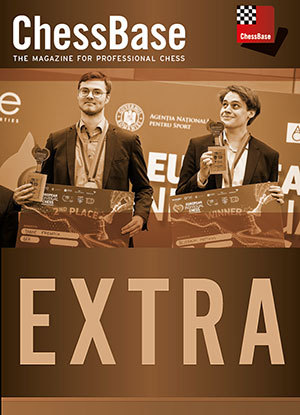
ChessBase
Magazine issue 226
Extra
July 2025
ChessBase
http://www.chessbase.com
E-Mail
info@chessbase.com
ISSN 1432-8992
Euro 14,90
System requirements:
Minimum: Pentium III 1 GHz, 1 GB RAM, Windows Vista, XP
(Service Pack 3), DirectX9 graphic card with 256 MB RAM, DVD-ROM drive,
Windows Media Player 9, ChessBase 12/Fritz 13 or included Reader and
internet connection for program activation. Recommended: PC Intel Core
i7, 2.8 GHz, 4 GB RAM, Windows 8.1 or Windows 10, DirectX10 graphic
card (or compatible) with 512 MB RAM or better, 10
The main files of this heavy loaded CBM is good for 50932 latest played
games plus an extra bag of 39 well analysed games.
A fine example of play is:
Druska,Juraj (2433) - Durucay,Uygar (2226) [B12]
EU-ch 24th Petrovac (5), 12.11.2024
[Druska,Juraj]
1.e4 c6 2.d4 d5 3.f3!? e5?! Not the most precise way to meet Fantasy
Variation. 4.dxe5 Db6 [4...Lc5 5.Pc3 Db6 More common move order.]
5.Pc3! Lc5 6.Pa4 Da5+ [6...Lf2+ Another option, objecively more
stubborn, but Black will not find equality. 7.Ke2 Dd4 8.Dxd4 Lxd4 And
White already can choose from multiple good options. 9.Lf4 (9.f4 dxe4
10.Le3 Lxe3 11.Kxe3²; 9.exd5 Lxe5 10.Pc3!?f With
î?¤f2 î?¨ge2 next, White is certainly having
some initiative. 10...Lf5?! 11.Kf2 Lxc2 12.Pge2²) 9...b5
10.Pc3²] 7.c3 Lxg1 8.Txg1 dxe4 White is already much better and
can choose from multiple options. 9.f4 [9.Dd4 Pe7 (9...Pd7? 10.e6 fxe6
11.Dxg7+-) 10.Lg5 Pd7 11.Lxe7 Kxe7 12.f4 Td8 13.0-0-0 Pf8 14.Dxd8+ Dxd8
15.Txd8 Kxd8 16.c4² Followed by g3 î?§g2, White is the
one having all the fun in this endgame.;
9.Lf4 Pe7 10.b4 Dd5 11.Dc2± Followed by î?¦d1,
White is doing great.] 9...Pe7 10.Dd4? White should have focused on
bringing the î?¨a4 to the game as quickly as possible.
[10.b4! This was the way to continue. White gains some tempi, and the
Knight on a4 will get to play soon. 10...Dd5 (10...Dc7 11.Pc5±
Followed by î?¨xe4, White will gain the pawn in much more
favorable version than in the game.) 11.c4 (11.Lb2±) 11...Dxd1+
12.Kxd1± White's position is to be preferred due to weak pawn on
e4, Bishop pair, and Black's problem to develop light-squared Bishop
(î?¦g1 helps with the possible advance h3 g4).;
10.Ld2!?± Another way to bring the knight into the game, White
will continue with c4 and î?¨c3.] 10...0-0? Not precise.
[10...Pd7!= Preventing î?¨c5, Black is fine. 11.Ld2? e3! If
this pawn is taken, the knight on a4 is lost. 12.Lc1 0-0³]
11.Dxe4? Not in the spirit of the position. White postpones bringing
his î?¨a4 to the game, and somehow now his pieces will lack
the coordination. [11.Pc5! Td8 12.Df2!± (12.Db4 Dxb4 13.cxb4 Pd5
14.Pxe4 Pxb4 15.Kf2²) ] 11...Pa6! Creating the threat of b5,
showing White the weakness of the placement of î?¨a4. 12.Lxa6
[12.g4!? Engine's approach to go for a very complex battle. It is based
on a cute tactics, the î?¨a4 will be saved after b5, because
the queen would have been trapped after
î?§d3-î?§c2. 12...b5 13.Ld3 g6 (13...Pg6! 14.Dxc6
bxa4 15.Dxa8 Pc5 16.Df3 Ph4! 17.De2 Pxd3+ 18.Dxd3 Td8 19.De4 h5÷
Black has a huge counterplay.) 14.b4 Dc7 (14...Dxa4?? 15.Lc2+-)
15.Pb2!÷ With a complex fight. Black will probably play c5 or
f5, and the game will ba chaotic. White should be happy, due to his
Bishop pair, but the position is quite unclear.(15.Pc5 Pxc5 16.bxc5
Pd5= Another complex battle, but if feels like Black should be fine.) ]
12...Dxa6 13.Pc5 [13.b3!f The last chance for White to retain the
opening advantage. Next would be î?¤f2 î?¨c5
î?¥f3 î?¨e4, maybe even g4. But it is becoming more
and more clear that the mistake was not bringing î?¨a4 to the
game earlier.] 13...Db6 14.Db4 Asking Black some questions, White is a
pawn up after all. 14...Dc7?! Black decides to keep queens, and plans
to strike in the centre with f6. But the time is important factor, and
this approachis not right. [14...Pd5 15.Dxb6 axb6 16.Pe4² This is
what White wants, a risk-free scenario with a pawn up.;
14...Dxb4! 15.cxb4 f6! Black will have a sufficient compensation here.
16.exf6 (16.Ld2 fxe5 17.fxe5 Pg6 18.Lc3 b6=) 16...Txf6 17.Ld2 Pg6 18.g3
b6=] 15.Pe4? White loses the important time, a main problem is that f6
is actually not prevented. [15.Ld2! f6 16.0-0-0± White finished
his development, and will enjoy a very pleasant initiative.] 15...f6!
16.Ld2? The same treatment doesn't work anymore. [16.exf6?? Pd5 17.Dd4
Lf5µ What a different picture, compared to the
15.î?§d2! variation, where White quickly castled.;
16.g4! This is a strong positional reply, covering the key f5 square,
and preparing to answer fxe5 with f5, where White would be better.
16...Pd5 (16...fxe5 17.f5²) 17.Dd6 (17.Db3=) 17...Db6 18.Dc5=]
16...fxe5 17.fxe5 Dxe5 18.0-0-0 Pd5 19.Dc4 Lf5µ All of a sudden,
Black took the initiative, and is on a brink of having winning
advantage. 20.Tde1 b5 21.Dd4 Dxd4? Too cautious. [21...Dxh2-+ There was
nothing wrong with taking this pawn, and it would cause White serious
trouble. î?§f5 is a great defensing (and attacking) piece,
it is not clear where is White's compensation.] 22.cxd4 Tae8 Black is,
obviously, still in a better shape, but this careful approach will not
be enough to convert it to the full point. 23.Pg5! From now, White is
doing a great job, holding Black back. 23...Lg4 24.Txe8 Txe8 25.h3! Le2
[25...Ld7 26.g4=] 26.Te1! Te7 [26...h6 27.Pf3=] 27.h4 h6 28.Ph3 Lc4
29.Te5? Giving up a pawn for no reason. [29.Txe7! Pxe7 30.b3= Followed
by î?¨f4 and the game should end in a draw soon.] 29...Txe5?!
[29...Tf7µ Keeping the rooks with a threat of î?§f1
would have been a strong practical choice in the time scramble.]
30.dxe5 Lxa2 31.Pf4 Pxf4 32.Lxf4= When taking 29...Rxe5, Black decided
to go to this endgame. Obviously, it's risk-free for Black, and one
could picture scenarios how Black can win it. Objctively it's just
draw, but as we will see, Black will have a chance to put a lot of
pressure. 32...Kf7 33.Kc2 Ld5 34.g4 [34.g3! White should be patient.
34...a5 (34...Ke6 35.b4 Kf5 36.Kc3 c5!? (36...g5 37.hxg5 hxg5 38.Le3=)
37.bxc5 a5 38.e6 Kxe6 39.Lc7 b4+ 40.Kc2 a4 41.La5!=) 35.Ld2 a4 (35...b4
36.Le3 Ke6 37.Lb6=) 36.Kc3 Ke6 37.Kd4 Kf5 38.Lb4 h5 39.Lf8 g6 40.e6
Kxe6 41.Kc5= With the easy draw. On the other hand, in time trouble it
is not easy for White to calculate through all these nuances. 41...Kf5
42.Kb4 Kg4 43.Ld6 Kf3 44.Le5 Ke4 45.Ld6 Kd3 46.Le7 (46.Le5?? Wrong
approach, Bishop needs to stay on a3-f8 diagonal to cover c5/b4 pushes
push, while î?¤a3 will cover b2 pawn. 46...Kc2 47.Lf6 Lc4
48.Le5 c5+ 49.Kxc5 Kb3-+ Followed by b4 and a3, White's King is too far
away.) 46...Kc2 47.Ka3=] 34...Ke6?! Black doesn't put pressure in the
most precise way. [34...a5! Stopping b4 for good. 35.Kc3 Le6! 36.g5 h5
Black restricted White's Bishop, now he will put pressure by advancing
his King. 37.Kd4 Ld5 38.Ld2 a4 39.Kc5 Ke6 40.Lc3 g6 41.Ld4 Kf5 42.Lc3
Kg4 43.Le1 Lb3 44.Lf2 Kf3 45.Le1 Ke2 46.Lc3 Kd3 47.Le1 (47.Kxc6?? a3;
47.La5 Ld5 48.Kb4 Ke4) 47...Ld5 48.Kb4!= The only move, as Black was
threatening î?¤c2 î?§c3 a3-+. 48...Ke4 49.Lc3
(49.Lg3 Kf3 50.Le1 Kf4 51.Lc3 Ke4 Here, White also needs to give up the
e-pawn, as î?¤c5?? loses to î?¤d3
î?¤b4 î?§c4! with the idea c5+
î?¤xc5 a3-+) 49...Lc4 Zugzwang, White needs to give up the
e-pawn 50.e6 (50.Kc5?? Kd3 51.Kb4 c5+ 52.Kxc5 a3-+) 50...Lxe6 51.Le1!
Kf3 52.Ld2 Ke2 53.Lf4 Kd3 54.Ld6! Kc2 55.Ka3] 35.Kc3 Lf3 [35...a5
36.Kd4 a4 37.Ld2=] 36.g5 hxg5 [36...h5 37.Kb4= (37.b4 c5 38.Le3!
(38.bxc5?? The position still has some life in it, and White can go
wrong. 38...a5-+ And White is in trouble.) ) ] 37.Lxg5 Kxe5 38.Le3 a6
39.Ld4+ Kd5 40.Lxg7 c5 41.b4 cxb4+ 42.Kxb4 ½-½
But there is more:
1.e4 c5 2.Nf3 d6 3.d4 cxd4 4.Nxd4 Nf6 5.Nc3 a6 6.h3 e5 7.Nb3
In ChessBase Magazine #226 and the upcoming issue #227, Luis Engel
presents a
comprehensive analysis of the Najdorf Variation with 6.Bd3. ‘In
between’, in this CBM Extra,
the GM from Hamburg focuses on another variation in his favourite
opening: after 6.h3 e5, White
has recently preferred the continuation 7.Nb3. ‘A very dangerous
variation – for both sides!’
On the seventh move, Black has a choice between two moves that take the
game in very different
directions. Video playing time: 33 minutes!
1.e4 c5 2.Nf3 e6 3.d4 cxd4 4.Nxd4 Nc6 5.Nc3 Qc7 6. Be3 a6 7.Qf3 Nf6
8.0-0-0 Ne5 9.Qg3 b5 10.a3
For some time now, 7.Qf3 has been very popular as a weapon against the
Taimanov Variation –From f3, the queen
may move forward to g3, where it can target the pawn on g7 and
offer an exchange
of queens that is favourable for White. In the game
Trost-Donchenko (Grenke Open 2025),
which Nico Zwirs uses as the starting point for his analysis, the
main moves 7...Nf6 8.0.
0.0 Ne5 9.Qg3 b5 followed. At this point, the young IM from Sweden
refrained from the s
tandard continuation 10.f4 – which requires extensive theoretical
knowledge – and instead
played the clever 10.a3, allowing 10…Bb7 11. Bf4! – this move has
only been played once
before. 11...d6 is practically forced, and here Trost sacrificed
his knight for two pawns
and a strong initiative with 12.Nxb5 axb5 Bxb5+. Even a player of
Donchenko's calibre was
unable to solve the concrete problems
of this position over the board. ‘A very nice piece of opening
preparation!’
Conclusion: This is must have material
and for a bargain price!
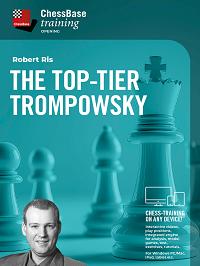
The top-tier Trompowsky
by Robert Ris
http://www.chessbase.com
E-Mail
info@chessbase.com
2025
Price Euro 49.90
Windows 7 or higher
Minimum: Dual Core, 2 GB RAM, DirectX11, graphics card with 256 MB RAM,
DVD-ROM drive, Windows Media Player 9, ChessBase 14/Fritz 16 or
included Reader and internet access for program activation.
Recommended: PC Intel i5 (Quadcore), 4 GB RAM, Windows 10, DirectX11,
graphics card with 512 MB RAM or more, 100% DirectX10-compatible sound
card, Windows Media Player 11, DVD-ROM drive and internet access for
program activation.
MacOSX only available as download! Minimum: MacOS "Yosemite" 10.10
The well known online chess trainer IM Robert Ris from the Netherlands
provides the user an impressive over eight hour coverage of the
Trompowsky 1.d4 Nf6 2.Bg5.
Even today a surprise weapon and pre game preparation can be kept to a
minimum.
First to the contents:
Introduction
1.d4 Nf6 2.Bg5 Main Lines: 2...Ne4/e6/c5
1.d4 Nf6 2.Bg5 c5 3.d5 Qb6
1.d4 Nf6 2.Bg5 c5 3.d5 d6/g6
1.d4 Nf6 2.Bg5 Ne4 3.h4 Nxg5
1.d4 Nf6 2.Bg5 Ne4 3.h4 h6
1.d4 Nf6 2.Bg5 Ne4 3.h4 d5
1.d4 Nf6 2.Bg5 Ne4 3.h4 c5
1.d4 Nf6 2.Bg5 e6 3.e4 Be7/d5/c5
1.d4 Nf6 2.Bg5 e6 3.e4 h6 4.Bxf6 Qxf6 5.Nc3 b6/Bb4
1.d4 Nf6 2.Bg5 e6 3.e4 h6 4.Bxf6 Qxf6 5.Nc3 d6
1.d4 Nf6 2.Bg5 d5
1.d4 Nf6 2.Bg5 d5 3.Nd2 c5 4.dxc5 e6/e5/Qa5/Nc6
1.d4 Nf6 2.Bg5 d5 3.Nd2 c5 4.dxc5 e6 5.e4 Bxc5 6.e5 Qb6
1.d4 Nf6 2.Bg5 d5 3.Nd2 Bf5
1.d4 Nf6 2.Bg5 d5 3.Nd2 h6
1.d4 Nf6 2.Bg5 d5 3.Nd2 e6 4.e4 Be7 & Sidelines
1.d4 Nf6 2.Bg5 d5 3.Nd2 e6 4.e4 dxe4 5.Nxe4 Nbd7/Be7
1.d4 Nf6 2.Bg5 Sidelines: 2...g6/c6/Nc6
1.d4 Nf6 2.Bg5 c6 3.Bxf6 gxf6/exf6
1.d4 Nf6 2.Bg5 Nc6 3.d5
1.d4 Nf6 2.Bg5 g6 3.Bxf6 exf6 4.c4 d5 5.cxd5 Qxd5 6.Nc3
1.d4 Nf6 2.Bg5 g6 3.Bxf6 exf6 4.c4 Bg7 5.Bc3 f5
1.d4 d5 2.Bg5
1.d4 d5 2.Bg5 f6 3.Bf4
1.d4 d5 2.Bg5 c5 3.e3 Qb6/Nc6
1.d4 d5 2.Bg5 c5 3.e3 Nf6 4.Bxf6 gxf6/exf6
1.d4 d5 2.Bg5 c6 3.e3
1.d4 d5 2.Bg5 h6 3.Bh4 c6 4.e3/Nf3
1.d4 d5 2.Bg5 h6 3.Bh4 c5 4.e3
Other Lines
Dutch: 1.d4 f5 2.Bg5
1.d4 d6 2.Bg5
Winawer French: 1.d4 e6 2.e4 d5 3.Nc3 Bb4 Nge2
Classical French: 1.d4 e6 2.e4 d5 3.Nc3 Nf6 4.Bg5
Englund Gambit: 1.d4 e5
1.d4 g6 2.h4
Outro
Exercises
Exercise 1
Exercise 2
Exercise 3
Exercise 4
Exercise 5
Exercise 6
Exercise 7
Exercise 8
Exercise 9
Exercise 10
Repertoire Training
1...Nf6 2.Bg5 c5
1...Nf6 2.Bg5 Ne4
1...Nf6 2.Bg5 e6
1...Nf6 2.Bg5 d5
1...Nf6 2.Bg5 c6/g6/Nc6
1.d4 f5 2.Bg5
1.d4 d5 2.Bg5
1.d4 e6
Other 1st move options
Practice Positions
Position 1
Position 2
Position 3
Position 4
Position 5
Position 6
Position 7
Position 8
Position 9
Position 10
Position 11
Position 12
Position 13
Position 14
Position 15
Bonus
Model Games
In this download there is besides all the latest developments a fine
coverage of strategy and tactics of this exciting opening.
Conclusion: A must for all lovers of
the Tromp!
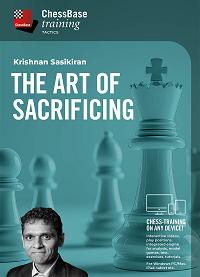
The Art
of Sacrificing
by Krishnan Sasikiran
http://www.chessbase.com
E-Mail
info@chessbase.com
2025
Price Euro 49.90
Windows 7 or higher
Minimum: Dual Core, 2 GB RAM, DirectX11, graphics card with 256 MB RAM,
DVD-ROM drive, Windows Media Player 9, ChessBase 14/Fritz 16 or
included Reader and internet access for program activation.
Recommended: PC Intel i5 (Quadcore), 4 GB RAM, Windows 10, DirectX11,
graphics card with 512 MB RAM or more, 100% DirectX10-compatible sound
card, Windows Media Player 11, DVD-ROM drive and internet access for
program activation.
MacOSX only available as download! Minimum: MacOS "Yosemite" 10.10
The no better way to improve your chess skills than doing sacrifices
and this nine hour download from Krishnan Sasikiran is more them
impressive, this chess Grandmaster from India,who was once the second
Indian to reach the legandary 2700 Elo border after former World
Champion Vishy Anand. His peak Elo was 2720 (2012) which made him to
one of the best of the world.
Introduction
Pawn Sacrifices
Sacrificing a Pawn for Long Term Initiative
Sacrificing a Pawn for Initiative Part 1
Sacrificing a Pawn for Initiative Part 2
Sacrifice a Pawn to Restrict your Opponent Part 1
Sacrifice a Pawn to Restrict your Opponent Part 2
Sacrifing a Pawn for Long Term Active Play Part 1
Sacrifing a Pawn for Long Term Active Play Part 2
Exchange Sacrifices
Exchange Sacrifice Part 1
Exchange Sacrifice Part 2
Sacrificing for the Attack
Sacrificing for the Attack Part 1
Sacrificing for the Attack Part 2
Queen Sacrifice
Queen Sacrifice Part 1
Queen Sacrifice Part 2
Playing Against the Sacrifice
Accepting the Sacrifice and Creating a Counter Attack
Playing Against the Exchange Sacrifice
Enduring the Sacrifice Induced Attack Part 1
Enduring the Sacrifice Induced Attack Part 2
Practice Positions
Throughout the video course, Krishnan Sasikiran shows various examples
from his career to explain sacrifices for initiative, an attack, a
better pawn structure and much more. Being a conceptual player, he
explains the thought process and emotions during his games and dives
into his decision making over the board. Occasionally, the student is
asked to calculate blindfold along with him, so that visualization and
calculation of variations are also part of the training process.
Conclusion: Highly instructive!
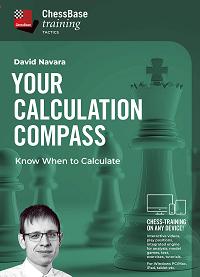
Your
Calculation Compass: Know When to Calculate
by David Navara
http://www.chessbase.com
E-Mail
info@chessbase.com
2025
Price Euro 19.90
Windows 7 or higher
Minimum: Dual Core, 2 GB RAM, DirectX11, graphics card with 256 MB RAM,
DVD-ROM drive, Windows Media Player 9, ChessBase 14/Fritz 16 or
included Reader and internet access for program activation.
Recommended: PC Intel i5 (Quadcore), 4 GB RAM, Windows 10, DirectX11,
graphics card with 512 MB RAM or more, 100% DirectX10-compatible sound
card, Windows Media Player 11, DVD-ROM drive and internet access for
program activation.
MacOSX only available as download! Minimum: MacOS "Yosemite" 10.10
The former chess prodigy David Navara 1985 provides the user with a
fine calculation course of 1 hour and 34 minutes, and covers:
introduction
Lazy man's guide to when not to calculate
Time Management
Method of Comparison
Candidate Moves
Step by step
Long variation, wrong variation
One move further
Intermediate moves
Opponent's Tactics
Invisible moves
Evaluation
Seeking a unicorn
Critical moments
Radical measures
Summary
In this video course, Grandmaster David Navara shares practical advice
on when to calculate deeply in a position — and just as importantly,
when not to.
Conclusion: Very instructive! Highly
recommended for beginners in chess!
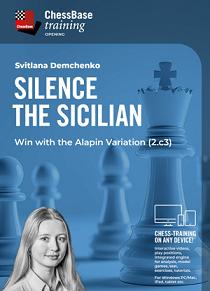
Silence the Sicilian -
Win with the Alapin Variation (2.c3)
by Svitlana Demchenko
http://www.chessbase.com
E-Mail
info@chessbase.com
2025
Price Euro 39.90
Windows 7 or higher
Minimum: Dual Core, 2 GB RAM, DirectX11, graphics card with 256 MB RAM,
DVD-ROM drive, Windows Media Player 9, ChessBase 14/Fritz 16 or
included Reader and internet access for program activation.
Recommended: PC Intel i5 (Quadcore), 4 GB RAM, Windows 10, DirectX11,
graphics card with 512 MB RAM or more, 100% DirectX10-compatible sound
card, Windows Media Player 11, DVD-ROM drive and internet access for
program activation.
MacOSX only available as download! Minimum: MacOS "Yosemite" 10.10
WIM Svitlana Demchenko, born 2003, is a Ukrainian-born Canadian chess
player and provides the user with an detailed 6.5 hours study of
the Alapin Variantion 1.e4 c5.c3.
A time less concept and played by the best players in the world just
play and win!
As you can see in the contents the study from Demchenko is impressive!
Introduction
Overview
Chapter 1 - 2...g6
2...g6
Model Game: Pavasovic vs Lie
Chapter 2 - 2...e6
2...e6
Model Game: Popov vs Makarian
Chapter 3 - 2...Nc6
2...Nc6
Model Game: Miladinovic vs Kalezic
Chapter 4 - 2...d6
2...d6
Model Game: Szabo vs Arandjelovic
Chapter 5 - Other 2nd Moves
Other 2nd Moves
Model Game: Sveshnikov vs Kupreichik
Chapter 6 - 2...d5
2...d5 with 5...Bg4
Model Game: Deep Blue vs Kasparov
2...d5 with 5...e6
Model Game: Nisipeanu vs Chuchelov
Sidelines Part 1
Sidelines Part 2
Chapter 7 - 2...Nf6
2...Nf6 - 5...d6
2...Nf6 - 5...e6
2...Nf6 - 5...Nc6
Model Game: Howell vs Ansell
Model Game: Pavasovic vs Atlas
Exercises
Exercise 1: Anand - Gaertner
Exercise 2: Cherniaev - Slavin
Exercise 3: Zvjaginsev - Vovk
Exercise 4: Arencibia - Garcia
Exercise 5: Predke - Iskandarov
Exercise 6: Sermek - Cecchetti
Exercise 7: Rozentalis - Benitah
Exercise 8: Sveshnikov - Rustemov
Exercise 9: De Armas Perez - Hernandez Alvarez
Exercise 10: Alekhine - Podgorny
Exercise 11: Wang - Bocharov
Exercise 12: Vachier-Lagrave - Krasenkow
Exercise 13: Mammadov - Sjugirov
Exercise 14: Raja - Timofeev
Exercise 15: Pavasovic - Bokros
Repertoire Training
2...g6
2...e6
2...Nc6
2...d6
2nd Move Sidelines
2...d5 with 5....Bg4
2...d5 with e6
2...d5 Sidelines
2...Nf6
Practice Positions
Position 1 - 2...g6
Position 2 - 2...e6
Position 3 - 2...d6
Position 4 - 2...e5
Position 5 - 2...Nc6
Position 6 - 2...d5
Position 7 - 2...d5
Position 8 - 2...Nf6
Bonus
Analysis
Tactics
Practice Positions
Model Games
Conclusion:A truly well made study!
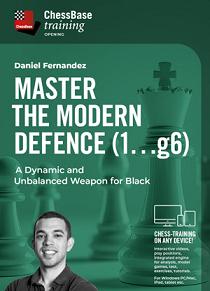
Master the Modern
Defence (1...g6) - A Dynamic and Unbalanced Weapon for Black
by Daniel Fernandez
http://www.chessbase.com
E-Mail
info@chessbase.com
2025
Price Euro 39.90
Windows 7 or higher
Minimum: Dual Core, 2 GB RAM, DirectX11, graphics card with 256 MB RAM,
DVD-ROM drive, Windows Media Player 9, ChessBase 14/Fritz 16 or
included Reader and internet access for program activation.
Recommended: PC Intel i5 (Quadcore), 4 GB RAM, Windows 10, DirectX11,
graphics card with 512 MB RAM or more, 100% DirectX10-compatible sound
card, Windows Media Player 11, DVD-ROM drive and internet access for
program activation.
MacOSX only available as download! Minimum: MacOS "Yosemite" 10.10
GM Daniel Fernandez comes with a five hour detailed and grandmaster
coverage of the move 1….g6,as we can see in the following contents:
Introduction
The Austrian Pirc Setup: 1.e4 g6 2.d4 Bg7 3.Nc3 d6 4.f4 Nf6 5.Nf3
1.e4 g6 2.d4 Bg7 3.Nc3 d6 4.f4 Nf6 5.Nf3 0-0: Ter Sahakyan vs Onischuk
Pirc Links to the Classical: 1.e4 g6 2.d4 Bg7 3.Nc3 d6 4.Be3 a6 5.a4 Nc6
1.e4 g6 2.d4 Bg7 3.Nc3 d6 4.Be3 a6 5.a4 Nc6: Caruana vs Aronian
King's Indian Defence Links: 1.e4 g6 2.d4 Bg7 3.Nf3 d6 4.c4 e5
1.e4 g6 2.d4 Bg7 3.Nf3 d6 4.c4 e5 5.Nc3 Nc6: Kalogeris vs
Papakonstantinou
1.e4 g6 2.d4 Bg7 3.Nf3 d6 4.c4 e5 5.Nc3 exd4: Firouzja vs Carlsen
The positional Nf3: 1.e4 g6 2.d4 Bg7 3.Nf3 d6
1.e4 g6 2.d4 Bg7 3.Nf3 d6 4.Be2 e5: de Waele vs Fernandez
1.e4 g6 2.d4 Bg7 3.Nf3 d6 4.c3 Nf6 5.Bd3 0-0 6.0-0 c5: Aronian vs
Artemiev
1.e4 g6 2.d4 Bg7 3.Nf3 d6 4.Bc4 Nf6: Sorensen vs Fernandez
1.e4 g6 2.d4 Bg7 3.Nf3 d6 4.Nc3 a6 5.a4 b6 6.Bc4 e6 7.0-0 Ne7 8.Re1 Nd7
9.Bf4 Bb7: Tomashevsky vs Carlsen
1.e4 g6 2.d4 d6 3.Nf3 Bg7 4.Nc3 a6 5.Be3 b5 6.Bd3 Bb7: Maatman vs
Fernandez
The 150 attack: 1.e4 g6 2.d4 Bg7 3.Nc3 d6 4.Be3 a6 5.Qd2
Introduction
1.e4 g6 2.d4 Bg7 3.Nc3 d6 4.Be3 a6 5.Qd2 b5 6.0-0-0: Erigaisi vs Carlsen
1.e4 g6 2.d4 Bg7 3.Nf3 d6 4.Nc3 c6 5.Be3 b5 6.Bd3 Nd7 7.h3: Bosiocic vs
Fernandez
1.e4 g6 2.d4 Bg7 3.Nc3 d6 4.Be3 a6 5.Qd2 b5 6.f3: Shankland vs Nakamura
1.e4 g6 2.d4 Bg7 3.Nc3 d6 4.Be3 a6 5.Qd2 b5 6.h4 h5 7.f3: Hecht vs Mons
Delaying d6: 1.e4 g6 2.d4 Bg7 3.Nc3 a6!?
1.e4 g6 2.d4 Bg7 3.Nc3 a6!?: Willow vs Moroni
The Gurgenidze Structure: 1.e4 g6 2.d4 d6 3.Nc3 c6
1.e4 g6 2.d4 d6 3.Nc3 c6 4.Be3 Nf6 5.f3 b5: Pranesh vs Carlsen
The Austrian Attack: 1.e4 g6 2.d4 Bg7 3.Nc3 d6 4.f4
1.e4 g6 2.d4 Bg7 3.Nc3 d6 4.f4 a6: Erdogdu vs Vrolijk
1.e4 g6 2.d4 Bg7 3.Nc3 d6 4.Be3 a6 5.f4 b5: Hague vs Fernandez
Exercises
Exercise 1
Exercise 2
Exercise 3
Exercise 4
Exercise 5
Exercise 6
Exercise 7
Practice Positions
Position 1 - The Austrian Pirc with 6.Bd3 and 7.e5
Position 2 - The Austrian Pirc with 6.e5 and 8.Bc4
Position 3 - Pirc Links
Position 4 - King's Indian Defence Links
Position 5 - Positional 3.Nf3
Position 6 - 3.Nf3 & 4.Bc4 Variation
Position 7 - Hippo Structure
Position 8 - 150 Attack
Position 9 - Gurgenidze Structure
Position 10 - Austrian Attack
Repertoire Training
The Austrian Pirc Attack
Pirc Links to Classical Variation
King's Indian Links
The positional Nf3
150 Attack 3.Nc3 4.Be3
Other 3.Nc3 systems
Bonus
Analysis
Model Games
The move order with 1.e4 g6 2.d4 Bg7 3.Nc3 d6 4.Be3 a6 5.f4 b5,black
does not mess around and does not prefer cramped positions but goes for
attack and that makes this DVD more than interesting!
Conclusion: Excellent grandmaster view
on the move 1…g6!
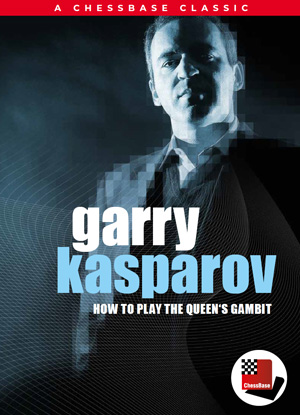
How to play the
Queen's Gambit
by Garry Kasparov
http://www.chessbase.com
E-Mail
info@chessbase.com
2025
Price Euro 49.90
Windows 7 or higher
Minimum: Dual Core, 2 GB RAM, DirectX11, graphics card with 256 MB RAM,
DVD-ROM drive, Windows Media Player 9, ChessBase 14/Fritz 16 or
included Reader and internet access for program activation.
Recommended: PC Intel i5 (Quadcore), 4 GB RAM, Windows 10, DirectX11,
graphics card with 512 MB RAM or more, 100% DirectX10-compatible sound
card, Windows Media Player 11, DVD-ROM drive and internet access for
program activation.
MacOSX only available as download! Minimum: MacOS "Yosemite" 10.10
In 2004, 13th World Chess Champion Garry Kasparov recorded a brilliant
made 3 hours video course on the Queen‘s Gambit. Now, ChessBase is
re-releasing this timeless classic in the modern ChessBase Media format
- complete with brand-new training features.
Contents
Introduction
Possible Deviations after 1.d4 d5 2.c4 e6
3...Nf6 4.Bg5 Be7 5.e3 0-0 6.Nf3 h6: Lasker Defence
3...Nf6 4.Bg5 Be7 5.e3 0-0 6.Nf3 Nbd7: Capablanca's Approach
3...Nf6 4.cxd5 exd5 5.Bg5 Be7 6.e3 0-0 7.Bd3 Nbd7 8.Nf3 c6: Carlsbad
Structure
3...Be7 4.cxd5 exd5 5.Bf4 c6 6.e3 Bf5: Alatorsev Variation
3...Be7 4.Nf3 Nf6 5.Bf4
3...Nf6 4.Nf3 Be7 5.Bg5 h6 6.Bh4 0-0 7.e3 b6: Tartakower System
3...Nf6 4.Nf3 Be7 5.Bg5 h6 6.Bxf6 Bxf6: Anti-Tartakower-System
Games Section
Introduction
Game 1: Steinitz vs. Lasker – St. Petersburg 1896
Games 2-4: Rubinstein’s Strategic Mastery
Game 5: Capablanca vs Alekhine, 1927
Game 6: Kasparov vs Andersson, 1988
Game 7: Kasparov vs Short, 1988
Game 8: Alekhine vs Lasker, 1934
Game 9: Beliavsky vs Geller, 1979
Game 10-12: Korchnoi vs Karopov 1981 & Karpov vs Kasparov 1984
Game 13: Karpov–Korchnoi 1981
Summary
Repertoire Training
Lasker Defence - 3...Nf6 4.Bg5 Be7 5.e3 0-0 6.Nf3 h6
Capablanca's approach - 3...Nf6 4.Bg5 Be7 5.e3 0-0 6.Nf3 Nbd7
Carlsbad Structure - Exchange Variation - 3...Nf6 4.cxd5 exd5 5.Bg5
Alatorsev Variation - 3...Be7 4.cxd5 exd5 5.Bf4
Queen's Gambit Declined with Bf4 - 3...Be7 4.Nf3 Nf6 5.Bf4
Tartakower Defence - 3...Nf6 4.Nf3 Be7 5.Bg5 h6 6.Bh4
Anti-Tartakower - 3....Nf6 4.Bg5 Be7 5.Nf3 h6 6.Bxf6
Practice Positions
Lasker Defence 1
Lasker Defence 2
Capablanca's Approach 1
Capablanca's Approach 2
Carlsbad Structure 1
Carlsbad Structure 2
Alatorsev Variation 1
Alatorsev Variation 2
5.Bf4 1
5.Bf4 2
Tartakower Defence 1
Tartakower Defence 2
Tartakower Defence 3
Anti-Tartakower 1
Anti-Tartakower 2
Bonus
Analysis
Games
Interactive exercises with video feedback: the authors present
exercises and key positions, the user has to enter the solution. With
video feedback (also on mistakes) and further explanations.
All videos and additional tasks, tests and texts included in the CB
books.
Sample games as a ChessBase database.
Conclusion: A Grand master work on the
Queens Gambit!






